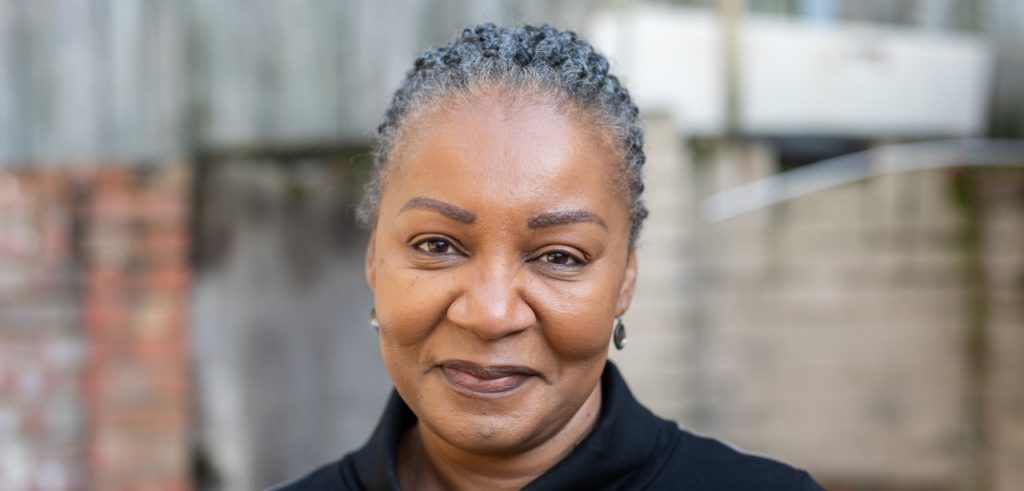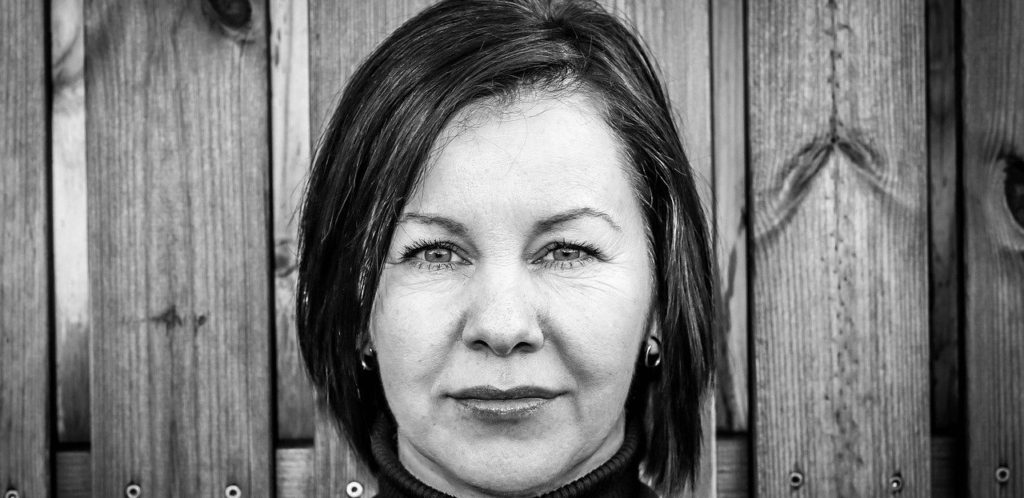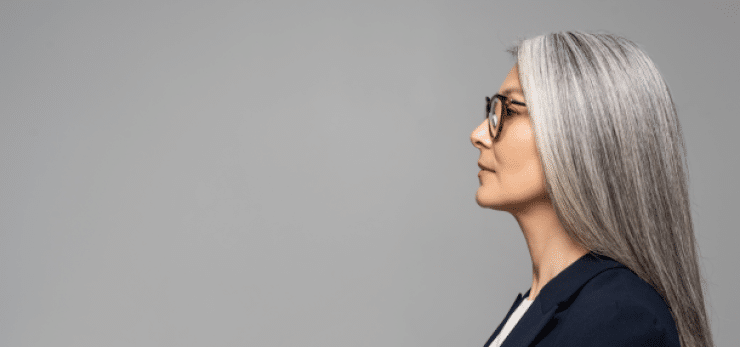I found my first gray hair at the age of 21.
By my mid-twenties I was regularly dying my hair to cover gray. Hated it. I’m not the type that enjoys hair styling or primping. I don’t enjoy salon appointments. And I hate using box dye.
During the pandemic shutdown, I let my hair go. It just didn’t feel important. I was an essential worker, at work every day, but work was time-consuming and I didn’t have anywhere else to go. So who cares?
The gray started to appear where it does – at the temples and that crazy shock at the top. It looked terrible but I didn’t care.
Then something began to happen. It wasn’t just gray at the roots. The old dye was fading and the gray was blending into the rest of my hair. My dark brown locks were starting to soften with interspersed gray strands. It didn’t look too bad.
In fact, I kind of liked it.

It was 2020 and most things were not so good. So, to ‘kind of like’ my hair was more than I could say for most things.
Plus, if I like this gray, there are so many benefits!
No more long, expensive hair appointments. I can avoid sitting in the salon chair for hours stressing over all the other things I should be doing – need to be doing. I can skip those Saturday mornings at the kitchen table, in a stained t-shirt, trying not to lean against the chair, waiting for my box-dye-soaked hair to cure.
Oh, yes. I kind of liked my graying hair. And I REALLY liked liking it.
If you’re like me, you’ve read all the reasons to transition to gray. It saves time, money, and the environment. Sure sure. And you’ve read different techniques to transition gracefully for the most effortless look. Yep yep.
What I am going to share with you are the other transitions. The simultaneous co-transitions that you may experience while transitioning to gray.
Transition #1 – From schedule hassles to less missed work
The hardest thing for me was scheduling a salon appointment. The color could take 3 hours or more and they wouldn’t schedule my appointment any later than 4 pm on a weekday.
Sometimes I could leave work before 4:00, but sometimes I couldn’t sneak out until 6:00. Worse, I didn’t know which kind of day it was until 3:00. I would try to schedule on weekends, but work might grab those days too, and anyway, my stylist was always booked.
I made my appointments optimistically two months in advance but started to worry as the appointment approached. And I almost always rescheduled. At least once.
Now, my appointments are 30 minutes or less. I can schedule them early or late – I can knock them out during a lunch break! Because I prefer simple, layered trims, I’m not picky about my stylist. I can schedule with whoever is available.
I pick a day and time that works for me and I don’t need the appointment months in advance. My hair appointment anxiety is gone. And I never have to miss work to get it done.
Transition #2 – From “You look young” to “You look good”
It’s a subtle distinction but it’s something to be prepared for.
I went to college in my mid-30s. For the most part, I could pass for 25ish and my classmates assumed I was just a couple of years older. When people discovered my age they all said the same thing. “I never would have guessed! You look younger!” I never tired of hearing it.
When I stopped dying my hair, these compliments disappeared and a new one surfaced. “You look good for your age.”
Nowadays, others easily accept I am in my 40s. I mean, just look at the hair. But all things considered, I look good for 40s. Healthy, fresh, energetic. I dig it. But it’s not the same.
Transition #3 – From fighting aging to natural aging
This is really a mindset. You have decided not to cover your natural signs of age. Letting your hair show age is noticeable and, like it or not, it’s a statement. You are getting older and you are fine with that.
Since I was 30 I have been consistently complimented on my youthful appearance. I worried that I liked it too much. I asked my husband to stop me from getting plastic surgery – just in case I tried to cling to youth.
We have all seen the women, and men, that try to stay too long at the young-and-pretty party. I didn’t want to be that.
I would like to think that I will accept my wrinkling face and thinning skin as it occurs slowly over time. It’s a natural process like childhood growth and puberty. I want to embrace it and take as good care of my body and mind as possible as I age.
Read: New research suggests gray hair can be reversed. But don’t cancel your hair appointment yet.
Allowing my hair to show age is the first step down this road for me.
Transition #4 – From “Will they notice?” to “What will they say?”
Hair dye is an overt cover-up. You worry you will be found out. I call it root anxiety. Will they see it? Is it obvious? You avoid an updo lest someone notice your silvery temples.

Does going gray resolve this anxiety? Not exactly. But it’s different.
In my experience, people straight up ask me about it.
“Are you growing out your gray?” or “Have you decided to go gray?”
Some people come right out and say, “I like your gray.” It’s a compliment and well-appreciated. But it’s awkward.
Weirdly, I tend to have a pre-gray reflex response. “Oh, crap! They noticed!” Of course they noticed. It’s noticeable.
But for the record, they noticed before. They just politely pretended not to. Now they might say something.
Transition #5 – From more hair maintenance to less
I love shorter, less frequent salon appointments. But it gets better. My hair needs less washing and less styling. Graying hair takes less time per month, per week, and per day.
My dark hair is fine and limp. It gets oily, falls flat, and doesn’t hold a curl. As my hair grays, this is all changing.
The courser texture absorbs oil, requiring fewer washes and less dry shampoo. As I avoid the chemical burns and frequent washes, it doesn’t shed so easily. It’s thicker and healthier. It’s more stylable with less product. It looks better with less work.
It even air dries nicely.
And voila. More time for me. I’ll take it.
Because I’m worth it (*wink*).

I appreciate your reflections and wonder when I will get to the point of allowing my hair to just be gray. I feel that as a female academic gray hair will be held against me by my students, who will perceive of me as older than they already do (which is old lol) and that administrators will start wondering if I will retire next year or not. What do you think of this?
Hi Wendy!
Only you know your surroundings and the people you work with, as well as what makes you feel comfortable. My initial reaction is that an academic who is viewed as older could be seen as more credible and could possibly work in your favor. But, I have definitely known people who have felt the need to keep their hair dyed to avoid any employer discrimination, real or perceived. As you say, you don’t want them to think you are on your way out.
However, from my perspective, there has never been a better time socially to go gray. Besides silver being a trend among the younger generations, the pandemic has really shifted priorities for people. In most circles, in my experience, it has become perfectly acceptable to decide that spending extra time and money on something superficial is not a priority for you. And besides, gray can look really great!
Of course, it is also acceptable to decide that hair color is a priority for you if it makes you feel good.
I think you’ll know when it’s time! Thanks for the comment!